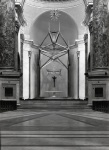THE SIXTIES: PLAYING WITH SURFACES
During the fifties and the sixties Gio Ponti's inventiveness, in architecture and in design, continued to grow, reaching a peak in the seventies. Gio Ponti's great age (or the splendid age as he called it when talking about Le Corbusier, the new Le Corbusier after Ronchamp, Chandigarh, and Ahmedabad had begun, in the happy sense of a vision that appeared or reappeared as he grew older. This can be seen not only in his designs, but in the way he published them in Domus, in an increasingly succinct and poetic manner even in the form of fables. And in the way he was talking more and more about form and imagination, of the reign of Beauty (like Van de Velde), beyond the problems. In this decade - a decade in which many great artists and architects died, a decade of hopes and fears (Giedion), and of a panorama of dawn, of revival, of new forms.- Ponti's thought and work were summed up in the maxim architecture is made to be looked at. Which is Ponti's last word, a synthesis of Vitruvius, in his own style. Ponti constructed and proposed. And from the ShuiHing building in Hong Kong, 1963, to the churches of San Francesco and San Carlo in Milan, 1964 and 1966, the INA buildings in Milan's Via San Paolo, 1967, the fronts of the Bijenkorf Stores in Eindhoven, 1967, and the designs for triangular, colored sky-scrapers, 1967, he was playing with surfaces, with apertures and cladding highly reflective, using diamond-faceted ceramic tiles and with facades that were «independent» of the structure and the plan. Architecture is made to be looked at, for it is also public landscape: facades are the walls of the street, and a city is made of streets; the facades are the visible part of the city, they are all of the city that appears.
From "Gio Ponti, l'opera" by Lisa Licitra Ponti,1990, Leonardo Editore
-
1960
-
1960
-
1960
-
1960
-
1960
-
1960 - 1961
-
1960 - 1964
-
1960 - 1964
-
1960 - 1965
-
1960 - 1970
-
1961
-
1961
-
1961
-
1961 - 1962
-
1961 - 1964
-
1961 - 1964
-
1962
-
1962
-
1962
-
1962
-
1962
-
1962
-
1962 - 1964
-
1963
-
1963
-
1963
-
1963
-
1963
-
1963
-
1963 - 1967
-
1964
-
1964
-
1964
-
1964 - 1070
-
1964 - 1970
-
1965
-
1966
-
1966
-
1966
-
1966
-
1966
-
1966
-
1966
-
1966
-
1967
-
1967
-
1967
-
1967
-
1967
-
1967 - 1968
-
1967 - 1969
-
1968
-
1968
-
1968
-
1968
-
1968
-
1969
-
1969














































